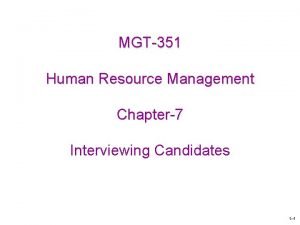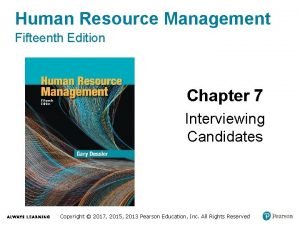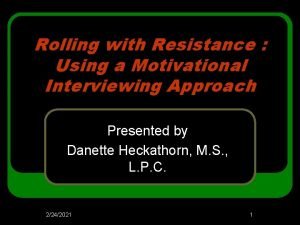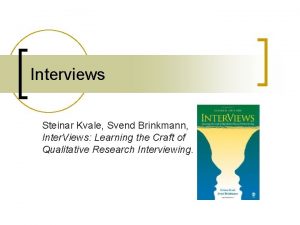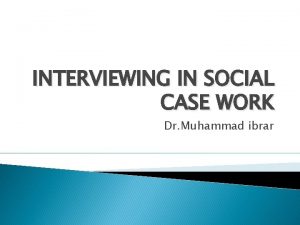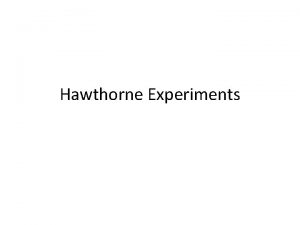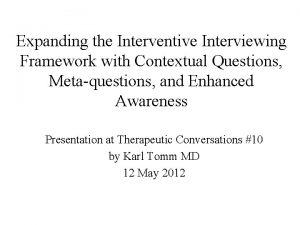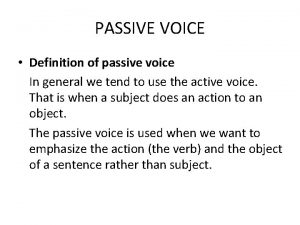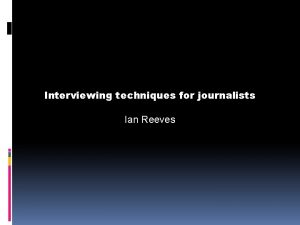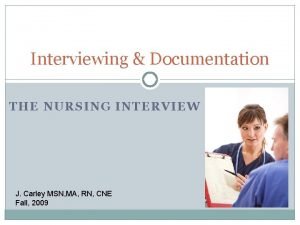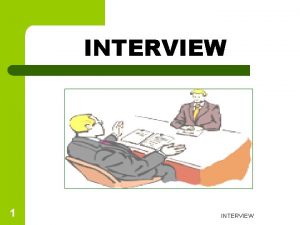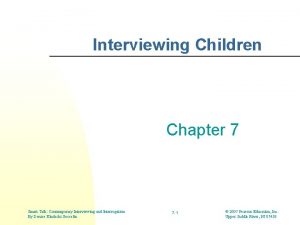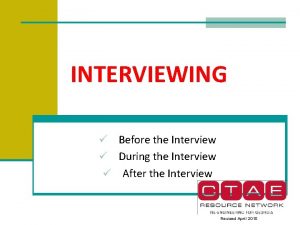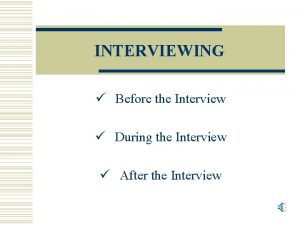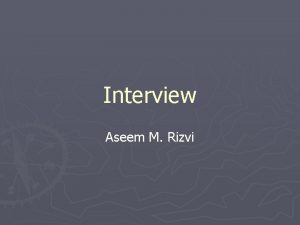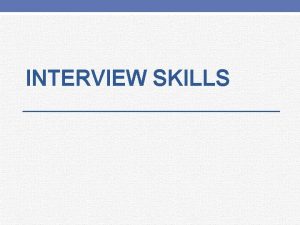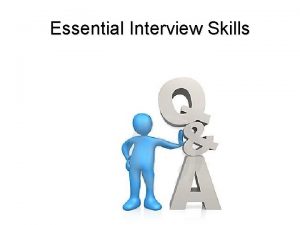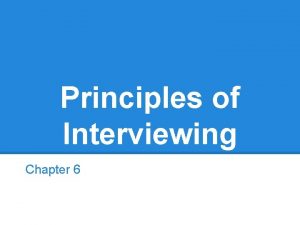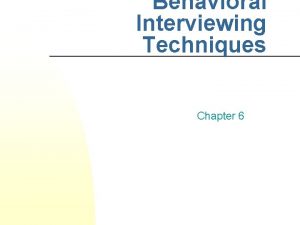Interviewing Children Chapter 7 The Child Interview n






















- Slides: 22

Interviewing Children Chapter 7

The Child Interview n n Smart Talk: Contemporary Interviewing and Interrogation By Denise Kindschi Gosselin Criminal investigators must determine what happened u Need disclosure from the child u Reliability will be an issue Social Service investigators determine if something happened which requires child protection 7 -2 PRENTICE HALL © 2006 Pearson Education, Inc. Upper Saddle River, NJ 07458

Limitations on Reporting by Age n n n Smart Talk: Contemporary Interviewing and Interrogation By Denise Kindschi Gosselin Infancy: the first 2 years u Rely on medical documentation Early Childhood: Ages 2 to 6 u Short attention span u Time and space are difficult concepts u Only in rare instances should the child be interviewed more than ½ hour Middle Childhood: Ages 7 to 12 u Language is well developed u Play remains primary expression u Emotion language possible u Can distinguish fiction vs. reality 7 -3 PRENTICE HALL © 2006 Pearson Education, Inc. Upper Saddle River, NJ 07458

Field Assessment: a first responder situation n Explain the reason for the visit to the caretaker u The child may need to be visually examined for bruises an marks « Secure emergency medical attention if needed u Smart Talk: Contemporary Interviewing and Interrogation By Denise Kindschi Gosselin Interview the child outside of the presence of the caretaker 7 -4 PRENTICE HALL © 2006 Pearson Education, Inc. Upper Saddle River, NJ 07458

Risk Assessment Step I: n n Assessing the present and future risk of harm to a child is a legal requirement in all states The standard of proof for reporting suspected abuse or neglect is mere suspicion n n Smart Talk: Contemporary Interviewing and Interrogation By Denise Kindschi Gosselin 7 -5 Is there any reason to believe that the child has been abused, neglected, or witnessed abuse towards a parent or sibling? Has the child received a suspicious injury? Are there weapons or ammunition that is accessible to this child? Does the primary caretaker abuse alcohol or drugs? Is the child depressed or suffering from lack of medical attention? PRENTICE HALL © 2006 Pearson Education, Inc. Upper Saddle River, NJ 07458

Models for Evaluating Abuse Step 2: n Smart Talk: Contemporary Interviewing and Interrogation By Denise Kindschi Gosselin Choice of evaluation model is based on the goals of the interview 1. Child Interview Model 2. Parent-Child Interaction Model 3. Multidisciplinary Team Approach 7 -6 1. Child interview is central for abuse determination – 2. Determination is based on expected behaviors between offending and non-offending parent and their offspring – 3. Premise: children rarely make false allegations Should not be used for criminal complaint Input from child professionals for abuse determination – Criminal investigator must have active participation PRENTICE HALL © 2006 Pearson Education, Inc. Upper Saddle River, NJ 07458

Preliminary Considerations Checklist Step 3: 1. 2. 3. 4. Smart Talk: Contemporary Interviewing and Interrogation By Denise Kindschi Gosselin Determine the Reason for questioning Determine the Purpose of the questioning Identify the Population Identify the Interviewer 7 -7 1. 2. 3. 4. The interview reason determines its length The purpose of the interview determines the model to be used The interview population determines the limitations of the interviewee The choice of interviewer depends on the population PRENTICE HALL © 2006 Pearson Education, Inc. Upper Saddle River, NJ 07458

Step 4: Remain Neutral 1. 2. 3. 4. 5. 6. What, if any, crime occurred? Who is the perpetrator? Where did it occur? When did it occur? Against who did it occur? How was it perpetrated? 1. 2. 3. 4. 5. 6. Smart Talk: Contemporary Interviewing and Interrogation By Denise Kindschi Gosselin 7 -8 Have crime elements been satisfied? Has an offender been identified? Has the location been specified? Has the time frame been determined? Has the victim been identified? Have the specifics been articulated? PRENTICE HALL © 2006 Pearson Education, Inc. Upper Saddle River, NJ 07458

Forensic Child Interviewing Phase I: Caretaker Instructions n Smart Talk: Contemporary Interviewing and Interrogation By Denise Kindschi Gosselin Prior to meeting with the child instructions should be provided to the caretaker 7 -9 PRENTICE HALL © 2006 Pearson Education, Inc. Upper Saddle River, NJ 07458

Forensic Child Interviewing Phase II: Evaluation n Smart Talk: Contemporary Interviewing and Interrogation By Denise Kindschi Gosselin Using the preliminary considerations checklist, conduct an evaluation of the upcoming interview 7 -10 PRENTICE HALL © 2006 Pearson Education, Inc. Upper Saddle River, NJ 07458

Forensic Child Interviewing Phase III: Prepare the Child n Smart Talk: Contemporary Interviewing and Interrogation By Denise Kindschi Gosselin Use the Comprehensive Monitoring (CM) Preparation Model 7 -11 PRENTICE HALL © 2006 Pearson Education, Inc. Upper Saddle River, NJ 07458

Comprehensive Monitoring (CM) Preparation Model n 1. 2. 3. Smart Talk: Contemporary Interviewing and Interrogation By Denise Kindschi Gosselin Prior to the interview this is a practice session with the child interviewee conducted by a noninterviewing person Practice identifying instances of noncomprehension Practice responding with verbalizations that indicate lack of understanding Increase the interviewee awareness of the negative consequences of responding to questions not fully understood 7 -12 PRENTICE HALL © 2006 Pearson Education, Inc. Upper Saddle River, NJ 07458

Forensic Child Interviewing Phase IV: Establish Rapport n Smart Talk: Contemporary Interviewing and Interrogation By Denise Kindschi Gosselin Establish rapport through age appropriate language 7 -13 PRENTICE HALL © 2006 Pearson Education, Inc. Upper Saddle River, NJ 07458

Forensic Child Interviewing Phase V: Conduct the Interview n n n Smart Talk: Contemporary Interviewing and Interrogation By Denise Kindschi Gosselin Establish that the child knows the difference between the truth and a lie Don’t use ‘cop talk’ Avoid the use of leading questions 7 -14 PRENTICE HALL © 2006 Pearson Education, Inc. Upper Saddle River, NJ 07458

Child Cognitive Interview 3 phase procedure Basics of the n Adapted from the adult version Step 1 focuses on developing rapport u Step 2 involves techniques designed to elicit from the child as complete a narrative account of the crime as possible. u Step 3 involves the use of additional memory-jogging techniques u Smart Talk: Contemporary Interviewing and Interrogation By Denise Kindschi Gosselin 7 -15 PRENTICE HALL © 2006 Pearson Education, Inc. Upper Saddle River, NJ 07458

Rapport & Prepare Step 1 n n Smart Talk: Contemporary Interviewing and Interrogation By Denise Kindschi Gosselin Develop rapport with the child in accordance with recommended guidelines Prepare child for the interviewer's questions through a set of four instructions 7 -16 PRENTICE HALL © 2006 Pearson Education, Inc. Upper Saddle River, NJ 07458

Rapport Development • • • Smart Talk: Contemporary Interviewing and Interrogation By Denise Kindschi Gosselin Do not ask child’s name – “You must be Mary. My name is Bob. ” Ask simple questions about the child’s world and provide information about yourself. Do not ask questions that could be regarded as coercive – “do you want to be my friend? ” Empathize with a nervous child’s feelings. Use positive, open-ended questions likely to promote conversation – “What are your favorite tv shows? ” 7 -17 PRENTICE HALL © 2006 Pearson Education, Inc. Upper Saddle River, NJ 07458

Prepare the Child with Four Instructions Give the child permission: n Not to know all of the answers! u There may be some questions that you don’t know the answers to, that’s ok. n Not to answer if they don’t want to! u You don’t have to answer, just tell me n Ask what you mean if they don’t understand! u If you do not know what I mean, ask me to say it in new words n Answer the same for repeat questions! u I may forget that I already asked you a question, you don’t have to change your answer. Smart Talk: Contemporary Interviewing and Interrogation By Denise Kindschi Gosselin 7 -18 PRENTICE HALL © 2006 Pearson Education, Inc. Upper Saddle River, NJ 07458

Narrative Report Step 2 n n n Smart Talk: Contemporary Interviewing and Interrogation By Denise Kindschi Gosselin This step is the most important! In the most recent version of cognitive interviewing these are the only two mnemonics used Reconstruct the circumstances mnemonic Be complete, report everything mnemonic 7 -19 PRENTICE HALL © 2006 Pearson Education, Inc. Upper Saddle River, NJ 07458

Interviewer Guidelines for Reconstruct the Circumstances mnemonic 1. Reconstruct circumstances. To keep the child grounded in reality and minimize fantasy the interviewer must avoid such terms as ‘pretend’ or ‘imagine. ’ Instead, instruct the child to “picture that time when … as if you were there right now. Think about what it was like there. Tell me out loud. Were there any smells there? Was it dark or light? Picture any other people who were there. What things were there? How were you feeling when you were there? Who else was there? Smart Talk: Contemporary Interviewing and Interrogation By Denise Kindschi Gosselin 7 -20 PRENTICE HALL © 2006 Pearson Education, Inc. Upper Saddle River, NJ 07458

Interviewer Guidelines for Report Everything mnemonic n Smart Talk: Contemporary Interviewing and Interrogation By Denise Kindschi Gosselin Be complete/report everything. Instruct the child to start at the beginning and tell everything that happened, from the beginning to the middle, to the end. Tell everything you remember, even little parts that you don’t think are very important. Sometimes people eave out little things because they think little things are not important. Tell me everything that happened. 7 -21 PRENTICE HALL © 2006 Pearson Education, Inc. Upper Saddle River, NJ 07458

Changing the Order and Perspective Mnemonic Step 3 n Use memoryjogging techniques to obtain new information u u Smart Talk: Contemporary Interviewing and Interrogation By Denise Kindschi Gosselin Change the order mnemonic Change the perspective mnemonic 7 -22 PRENTICE HALL © 2006 Pearson Education, Inc. Upper Saddle River, NJ 07458
 Interviewing candidates chapter 7 ppt
Interviewing candidates chapter 7 ppt Chapter 7 interviewing candidates
Chapter 7 interviewing candidates 패자트리
패자트리 Rolling with resistance meaning
Rolling with resistance meaning Contoh motivational interviewing
Contoh motivational interviewing Dears motivational interviewing
Dears motivational interviewing Motivational interviewing schizophrenia
Motivational interviewing schizophrenia Motivational interviewing basics
Motivational interviewing basics Motivational interviewing dears
Motivational interviewing dears Preparatory change talk examples
Preparatory change talk examples Motivational interviewing stages of change
Motivational interviewing stages of change Kvale seven stages of interviewing
Kvale seven stages of interviewing Components of social case work pdf
Components of social case work pdf Interviewing in action in a multicultural world
Interviewing in action in a multicultural world Mica splitting test room
Mica splitting test room Interventive questions
Interventive questions German motivational speech
German motivational speech She would reject the offer passive voice
She would reject the offer passive voice Motivational interviewing
Motivational interviewing Interviewing techniques journalism
Interviewing techniques journalism Performance based interviewing
Performance based interviewing Interviewing techniques in nursing
Interviewing techniques in nursing Interviewing techniques definition
Interviewing techniques definition
